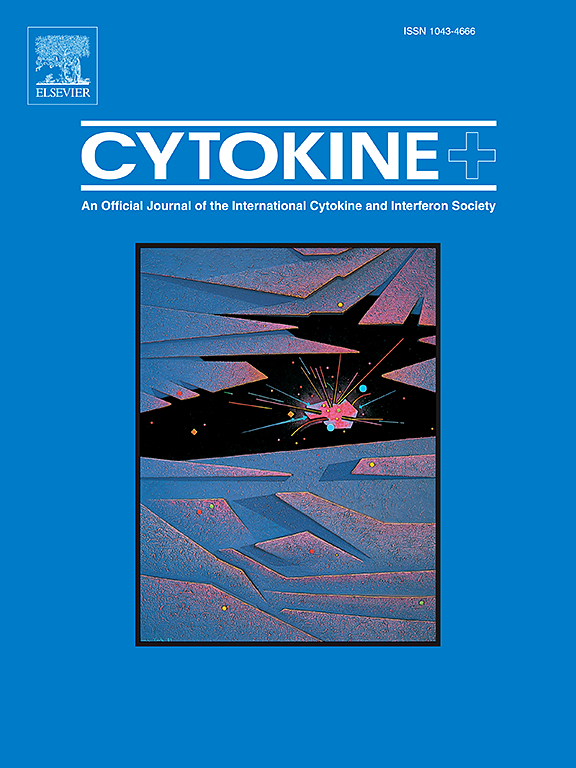通过邻近扩展试验确定免疫血清蛋白在骨质减少症中的诊断潜力。
IF 3.7
3区 医学
Q2 BIOCHEMISTRY & MOLECULAR BIOLOGY
引用次数: 0
摘要
背景:骨骼肌减少症以骨质疏松和骨骼肌减少并存为特征,受免疫功能障碍和全身性炎症的影响,但其具体作用尚不清楚。本研究旨在利用邻近扩展试验(PEA)研究骨骼肌减少症的炎症相关血清谱。方法:总共招募了50名有跌倒和骨折史的参与者,并将其分为三组,对照组,肌肉减少组和骨肌肉减少组。骨骼肌减少症在功能性骨骼肌减少症和骨质疏松症患者中诊断。功能性肌肉减少症是根据韩国肌肉减少症工作组的指南诊断的。骨质疏松定义为股骨颈面骨矿物质密度(aBMD) t评分≤-2.5。使用Olink®PEA炎症面板定量血清炎症蛋白水平,针对92种蛋白。结果:20种炎症相关蛋白被鉴定为差异表达蛋白(DEPs), 33种蛋白与全髋关节、股骨颈或腰椎的肌肉功能或aBMD的临床指标有显著相关性。加权基因共表达网络分析(Weighted Gene Co-Expression Network Analysis, WGCNA)鉴定出27个具有显著模块隶属关系和对组分离有贡献的蛋白。值得注意的是,包括SLAMF1、OPG、FGF-23和CSF-1在内的4种蛋白是dep,在WGCNA中具有显著意义,并与临床变量相关。主成分分析和热图分析显示,骨骼肌减少症是一个不同的实体,不同于肌肉减少症和对照组。生物信息学提示T细胞调节和肿瘤坏死因子结合能力在骨骼肌减少症的发生发展中起重要作用。结论:骨骼肌减少症表现出不同于骨骼肌减少症和对照组的独特免疫相关特征,强调炎症和适应性免疫在其发病机制中的潜在作用。本文章由计算机程序翻译,如有差异,请以英文原文为准。

Diagnostic potential of immune serum proteins in Osteosaropenia identified via proximity extension assay
Background
Osteosarcopenia, characterized by coexistence of osteoporosis and sarcopenia, is influenced by immunological dysfunction and systemic inflammation, however their specific roles remain unclear. This study aimed to investigate inflammation-related serum profiles in osteosarcopenia using the Proximity Extension Assay (PEA).
Methods
Overall, 50 participants with a history of falls and fractures were recruited and classified into three groups, controls, sarcopenia, and osteosarcopenia. Oseteosarcopenia was diagnosed in individuals with both functional sarcopenia and osteoporosis. Functional sarcopenia was diagnosed according to the Korean Working Group on Sarcopenia guidelines. Osteoporosis was defined as a T-score of the areal bone mineral density (aBMD) of the femoral neck ≤ −2.5. Serum inflammatory protein levels were quantified using the Olink® PEA inflammation panel, targeting 92 proteins.
Results
Twenty inflammation-related proteins were identified as differentially expressed proteins (DEPs), and 33 proteins showed significant correlations with clinical measures of muscle function or aBMD of the total hip, femoral neck or lumbar spine. Weighted Gene Co-Expression Network Analysis (WGCNA) identified 27 proteins with significant module membership and contribution to group separation. Notably, four proteins, including SLAMF1, OPG, FGF-23, and CSF-1 were DEPs, significant in WGCNA, and correlated with clinical variables. Principal component analysis and heatmap analyses revealed osteosacropenia as a distinct entity, differing from sarcopenia and controls. Bioinformatics suggested that T cell modulation and tumor necrosis factor binding capacity play significant roles in osteosarcopenia development.
Conclusions
Osteosarcopenia exhibited unique immune-related profiles distinct from those of sarcopenia and controls, emphasizing the potential role of inflammation and adaptive immunity in its pathogenesis.
求助全文
通过发布文献求助,成功后即可免费获取论文全文。
去求助
来源期刊

Cytokine
医学-免疫学
CiteScore
7.60
自引率
2.60%
发文量
262
审稿时长
48 days
期刊介绍:
The journal Cytokine has an open access mirror journal Cytokine: X, sharing the same aims and scope, editorial team, submission system and rigorous peer review.
* Devoted exclusively to the study of the molecular biology, genetics, biochemistry, immunology, genome-wide association studies, pathobiology, diagnostic and clinical applications of all known interleukins, hematopoietic factors, growth factors, cytotoxins, interferons, new cytokines, and chemokines, Cytokine provides comprehensive coverage of cytokines and their mechanisms of actions, 12 times a year by publishing original high quality refereed scientific papers from prominent investigators in both the academic and industrial sectors.
We will publish 3 major types of manuscripts:
1) Original manuscripts describing research results.
2) Basic and clinical reviews describing cytokine actions and regulation.
3) Short commentaries/perspectives on recently published aspects of cytokines, pathogenesis and clinical results.
 求助内容:
求助内容: 应助结果提醒方式:
应助结果提醒方式:


